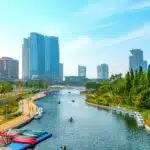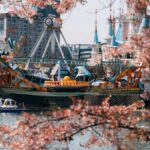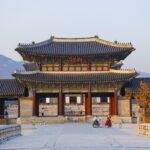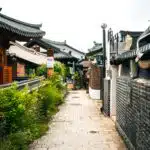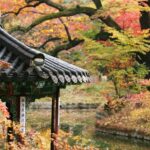Gyeongju, located in the southeastern part of South Korea, is often referred to as the “museum without walls” due to its rich historical and cultural heritage. As the capital of the ancient Silla Kingdom (57 BC – 935 AD), Gyeongju boasts a wealth of archaeological sites, temples, and artifacts that showcase its glorious past.


Highlights of Gyeongju
- Bulguksa Temple: A UNESCO World Heritage site, Bulguksa Temple is a masterpiece of ancient Buddhist architecture. Built in the 8th century during the Silla Dynasty,is renowned for its beautiful architecture, intricate stone pagodas, and serene surroundings.
- Seokguram Grotto: Adjacent to Bulguksa Temple, this 8th-century grotto houses a magnificent stone Buddha statue and offers panoramic views of the surrounding mountains.
- Cheomseongdae Observatory: One of the oldest astronomical observatories in East Asia, dating back to the 7th century, showcasing the advanced scientific knowledge of the Silla Kingdom.
- Anapji Pond: also known as Wolji Pond, A serene artificial pond surrounded by landscaped gardens and ruins of ancient palaces, offering a picturesque setting, especially during sunset.
- Gyeongju National Museum: Houses a vast collection of Silla artifacts, including gold crowns, pottery, and Buddhist relics, providing insights into the kingdom’s artistry and culture.
- Daereungwon Tomb Complex: Contains several large ancient tombs, including Cheonmachong (Heavenly Horse Tomb), which houses artifacts and replicas of royal Silla treasures.
- Yangdong Folk Village: A well-preserved traditional village showcasing the architecture and lifestyle of the Joseon Dynasty (1392–1897), designated as a UNESCO World Heritage site.
- Mount Namsan: Offers scenic hiking trails and panoramic views of Gyeongju and its surroundings, dotted with historical relics, Buddhist statues, and ancient carvings.




Cultural Significance
Gyeongju is not only a treasure trove of archaeological wonders but also a living testament to Korea’s cultural legacy. Its historical sites and artifacts reflect the achievements of the Silla Kingdom in art, architecture, science, and governance. Visitors to Gyeongju can immerse themselves in the splendor of ancient Korea while enjoying its natural beauty and tranquil atmosphere.
Modern Gyeongju
Today, Gyeongju is a blend of ancient history and modern amenities, offering visitors a unique opportunity to explore Korea’s past while enjoying comfortable accommodations, traditional cuisine, and vibrant cultural experiences. Whether you’re a history enthusiast, nature lover, or simply seeking a peaceful getaway, Gyeongju promises an unforgettable journey through time and culture.

